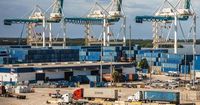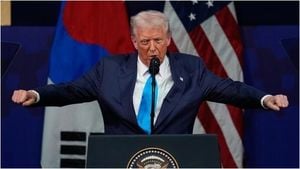The International Monetary Fund (IMF) has delivered a cautiously optimistic update on the global economy, raising its growth forecasts for 2025 amid a turbulent landscape shaped by U.S. tariff policies, surging investment in artificial intelligence, and persistent geopolitical tensions. While the latest World Economic Outlook, released on October 14, 2025, reveals that the world economy has weathered recent shocks better than initially feared, the report also underscores lingering risks and a fragile outlook for the years ahead.
According to the Associated Press, the IMF now expects the global economy to expand by 3.2% in 2025—an improvement over the 3% projection issued in July, but still reflecting a slight cumulative downgrade of 0.2 percentage points compared to last year’s forecasts. The outlook for 2026 remains unchanged, with global growth pegged at 3.1%. The United States, the world’s largest economy, is projected to grow by 2% in 2025 and 2.1% in 2026, both figures representing modest upgrades from previous estimates but also a noticeable slowdown from the robust 2.8% growth recorded in 2024.
IMF chief economist Pierre-Olivier Gourinchas, speaking at a news conference in Washington, explained, “The tariff shock itself is smaller than initially feared, with many trade deals and exemptions. Most countries also refrained from retaliation, keeping the trading system open. And the private sector also proved agile, front-loading imports and rerouting supply chains.” These actions, as detailed in the IMF report and echoed by Reuters, have helped cushion the immediate blow of the sweeping tariffs imposed by the Trump administration since April.
Despite these mitigating factors, Gourinchas cautioned, “The tariff shock is here, and it is further dimming already weak growth prospects.” The uncertainty generated by ongoing threats of additional tariffs—most recently, President Trump’s vow on October 10 to impose 100% duties on all Chinese imports—has rattled markets and cast a shadow over business investment. The IMF warned that should trade tensions escalate further, global growth could take a significant hit, with the risk of a 0.3 percentage point decline in output next year.
One of the more surprising supports for the U.S. economy has been the explosive investment in artificial intelligence. As reported by the Associated Press, “a burst of investment in artificial intelligence, in the form of huge data centers and extensive computing power, has helped offset the drag from trade and boosting the U.S. economy.” Shares of AI-focused firms such as AMD and Oracle have soared 80% this year, lifting consumer wealth and encouraging spending. Gourinchas drew a parallel to the late 1990s, saying, “There are echoes in the current tech investment surge of the dot-com boom of the late 1990s. It was the internet then, it is AI now.” However, he also warned that if an AI-driven financial bubble were to burst, it could sharply curtail both business investment and consumer spending.
Inflation remains a stubborn concern. The IMF expects global inflation to stay elevated at 4.2% in 2025 and 3.7% in 2026, with the United States seeing core inflation rise to 2.9%—up from 2.7% a year earlier. According to the IMF, most of the tariff costs are currently being absorbed by U.S. importers and retailers, but there are signs that these costs may gradually be passed on to consumers, heightening price pressures. Meanwhile, hiring in the U.S. has nearly ground to a halt, a development the IMF attributes in part to the uncertainty created by higher tariffs.
Elsewhere, the IMF’s report highlights the resilience and challenges facing major economies. China, for instance, is expected to see growth slow to 4.8% in 2025 and 4.2% in 2026—unchanged from previous estimates but down from 5% in 2024. The IMF notes that China has managed to cushion the impact of U.S. tariffs by redirecting exports to Europe and Asia and allowing its currency to depreciate, making its goods more competitive. However, the country’s property sector remains deeply troubled, with heavy debt loads and weak credit demand threatening longer-term stability. As Gourinchas put it, “It is increasingly hard to see how this could be sustained.”
In Europe, the outlook is mixed but slightly improved. The eurozone is now forecast to grow by 1.2% in 2025 and 1.1% in 2026, with Germany’s government boosting growth through increased military spending. Germany itself is expected to grow by 0.2% in 2025 and 0.9% in 2026, while France’s growth is projected to cool to 0.7% in 2025 before rising to 0.9% in 2026. Spain stands out as a bright spot, with growth upgraded to 2.9% in 2025 and 2% in 2026. The United Kingdom is expected to see steady growth at 1.3% in both years.
Emerging markets and developing economies have also shown resilience, benefiting from easier global financial conditions and, in some cases, robust policy frameworks. Türkiye, for example, saw its 2025 growth forecast raised to 3.5% (from 3%) and its 2026 outlook to 3.7% (from 3.3%), thanks to resilient domestic demand. However, inflation remains a challenge, with Türkiye’s rate projected to decline only gradually—from 33.29% in September 2025 to 34.9% for the year, and further down to 24.7% in 2026.
Other Asian economies are also faring well. India’s 2025 growth forecast was increased to 6.6% (from 6.4%), while Japan’s was raised to 1.1%, up 0.4 percentage points. In contrast, Russia is expected to see a marked slowdown, with growth dropping to just 0.6% in 2025 from 4.3% in 2024—a reduction of 0.4 percentage points from earlier expectations, largely due to the ongoing war in Ukraine.
Despite the more upbeat tone compared to earlier in the year, the IMF’s report, as summarized in its official blog, makes clear that “the outlook remains fragile, and risks remain tilted to the downside.” Persistent trade tensions, the possibility of further tariff hikes, and the threat of financial market volatility all loom large. The IMF stresses the importance of policy clarity, urging governments to “reduce uncertainty and set clear, transparent rules that reflect the changing nature of trade relations.”
Looking ahead, the IMF sees potential for improvement if policy uncertainty is resolved and AI-driven productivity gains materialize. “Clearer and more stable bilateral and multilateral trade agreements can raise global output by 0.4 percent in the very near term,” the Fund notes. Yet, the road ahead is anything but smooth, and the world’s major economies remain at a crossroads, balancing between resilience and risk.
As the global economy navigates the aftershocks of tariffs, technological change, and geopolitical strife, one thing is certain: the path forward will demand agility, cooperation, and a steady hand from policymakers and businesses alike.






